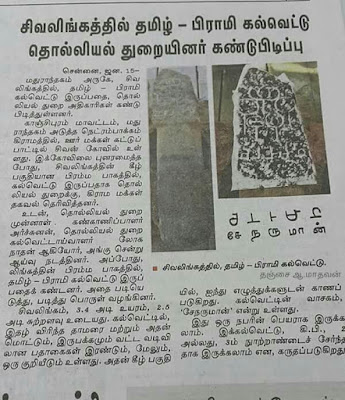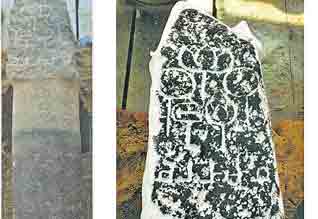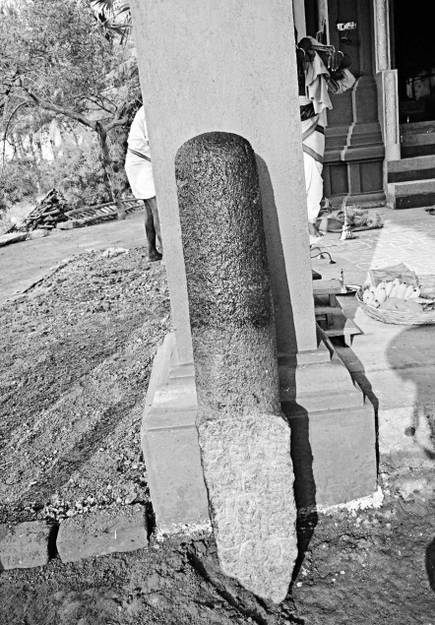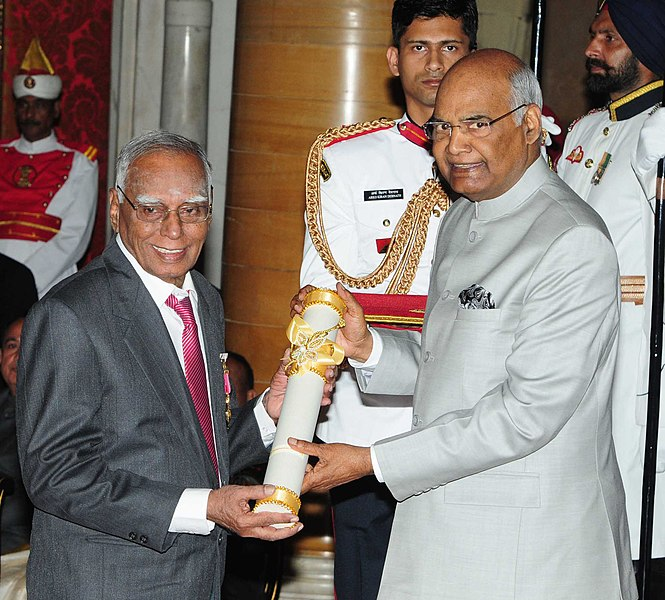நெற்றம்பாக்கம் சிவ லிங்கத்தில் சங்கத்தமிழ்க் கல்வெட்டு
192 views
Skip to first unread message
N. Ganesan
Aug 3, 2020, 10:24:09 PM8/3/20
to vallamai, housto...@googlegroups.com, padmavathy A, Ganesan V, S. V. Shanmukam, veerara...@gmail.com, murug...@gmail.com
மதுராந்தகம் வட்டம், நெட்ரம்பாக்கம் என்ற ஊரில் சிவாலயத்தில் உள்ள பழைய சிவலிங்கத்தில் தமிழ் பிராமிக் கல்வெட்டுக் கிடைத்துள்ளது. அது கி.பி. முதல் (அ) இரண்டாம் நூற்றாண்டைச் சார்ந்தது எனக் கல்வெட்டியல் துறையினர் கணித்துளர். “சேநருமான்” என எழுதிய கல்வெட்டு. இதில் புள்ளி இல்லை. இதற்கடுத்த கால கட்டத்தில் தொல்காப்பியரின் புள்ளிக் கோட்பாடு முழுதும் உள்ள கிண்ணிமங்கல லிங்கக் கல்வெட்டு “எகன் ஆதன் கோட்டம்” எனக் கிடைத்துள்ளது. சாதவாகனர் காசுகள், ஆண்டிப்பட்டிக் காசுகள் போல புள்ளியும், ஏகாரத்தின் உள்ளே புள்ளி இட்டு குறில் உயிரெழுத்து காட்டுவதாலும், கிண்ணிமங்கல முக லிங்கம் கி.பி. 200 எனலாம். கல்வெட்டியல் பேரறிஞர்கள் கணிக்கும் தொல்காப்பியர் புள்ளி வரும் காலத்துக்குக் கிண்ணிமங்கலம் அரண் செய்கிறது. முக லிங்கம் வட இந்தியாவில் ஏற்பட்டு சுமார் 100 - 150 காலம் சென்றபின் பாசுபத சைவ சமயிகள் கொணர்ந்தது கிண்ணிமங்கலத்தில். அதன் பின்னர் இணுவில் சிவாலயத்தில் உள்ள லிங்கத்தில் இருக்கிற தமிழ் பிராமி பற்றிப் பேரா. சி. பத்மநாதன் விவரித்துள்ளார். ஆக, மூன்று லிங்கங்களில் தமிழ் பிராமி உள்ளது. பின்னர், பல்லவ கிரந்தத்தில் எழுதிய லிங்கம் இந்தோனேசியாவின் தலைநகர் ஜாகர்த்தாவில் உண்டு. விழுப்புரம் தொல்லியல் அறிஞர் இன்னொரு லிங்க ஆவுடையாரில் எழுத்து இருப்பது பற்றி எனக்குத் தெரிவித்தார். கோவளம் கைலாயம் உடையார் கோவில் லிங்கத்தில் ஆவுடையாரில் 11-12 நூற்றாண்டு எழுத்தில் எழுதியுள்ளது (கல்வெட்டு இதழ், தமிழ்நாடு தொல்லியல் துறை, 2005). மொத்தம் 6 இலிங்கங்களில் எழுத்து கிடைப்பதால் லிங்க எழுத்துத் தொல்லியலின் பொற்காலம் என புலவர் செ. இராசு (ஈரோடு), வீரராகவன் - மங்கை (விழுப்புரம்) கருத்து தெரிவித்தனர்.
கிண்ணிமங்கலம் இலிங்கத்தில் தொல்காப்பியப் புள்ளி:
மூன்று சிவாலயங்களில் தான் தமிழ்
பிராமிக் கல்வெட்டுகள் கிடைத்துள்ளன: (1) நெட்ரம்பாக்கம் (2)
கிண்ணிமங்கலம். மற்ற சங்ககாலக் கல்வெட்டுக்களில் அனேகம் மலைக்குகைகள்,
கற்படுகைகளில் சமணர்களின் தொடர்புடையவை. கிண்ணிமங்கலம் இலிங்கத்தை தலைகீழாகத் திருப்பித் தான் எழுத்துக்களைப்
படிக்கவேண்டும். இதே போல, 2016-ல் கிடைத்த நெட்ரம்பாக்கம் இலிங்கத்திலும் “சேநருமான்”
என்று எழுதியுள்ளதைப் படிக்கச், சிவலிங்கத்தை 180 பாகை தலைகீழாகத்
திருப்பல் வேண்டும்.
மண்ணுக்குள் - பாதாள லோகம் சென்றுவிட்டதால், தலைவன் பேரை இவ்வாறு எழுதி,
ஈமச்சீர்கள் செய்து, சிவலிங்கத்தை நாட்டுவது வழக்கம் எனத் தெரிகிறது.
பள்ளிப்படைகொண்டான் பெயர் மண்ணுள்ளே மறைந்துவிடும். நெற்றம்பாக்கம்
லிங்கத்தில் நெய்தல் மலர்களும், இலைகளும் உள்ள தடாகமும், அத்துடன் தமிழ்
பிராமி எழுத்தும் பொறிக்கப்பட்டுள்ளன. நெய்தல் நீர்ப்பூத் தாவரம்
தொல்காப்பியத்திலே நெய்தல் திணைக் கடவுள் வருணன்
தொடர்பைக் காட்டுகிறது. இவை பற்றி விரிவாக எழுதியுள்ள கட்டுரை:
Ekamukha Linga with Tamil Brahmi
inscription in Kiṇṇimaṅkalam Ekanathan Mutt
3.0 Comparing Lingas of Netrambakkam and Kinnimangalam
 |
In 2016, Tamil Brahmi inscription on a large linga in Netrambakkam village Śiva temple was discovered. Dr. R. Nagaswamy read the inscription as, "cēntamān", https://www.thehindu.com/news/cities/chennai/Siva-Linga-with-early-Brahmi-inscription-found/article14009612.ece
However, upon re-examination, it is read as "cēnarumān", with cēnaru = armyfolk. cēnarumān will be son/heir of warriors. cēnaru is a tadbhava from sena, a Sanskrit word, while cēntan is Tamil for Murukan-Skanda. The most significant aspect of both the Netrambakkam and Kinnimangalam lingas is that they have to be rotated upside down for reading the script. From Tamil verb, cāy-tal, Sanskrit nouns like sayana 'bed', śava 'corpse' are derived. Extreme cāytal is 180 degree turn limit and this is done in memorial linga writing. The Netrambakkam lingam has Neytal 'blue water lily, nymphaea violacea' flowers, plant-symbol of Neytal Littoral (Sea) Landscape in Sangam texts showing the ancient connection of Linga form with Varuṇa, the neytal god. neytal paṟai is 'death drum' which Tiruvalluvar calls as "paṭāap paṟai". The Netrambakkam inscription, with Neytal flowers and leaves, is dated to 2nd or 3rd century CE. Similar date can be assigned to Kinnimangalam image and inscription.
நா. கணேசன்


N. Ganesan
Aug 5, 2020, 8:45:00 AM8/5/20
to vallamai, housto...@googlegroups.com, K Rajan, George Hart, sirpi balasubramaniam, mozhia...@googlemail.com, kalaik...@yahoo.com, Theodore Baskaran, Asko Parpola, kala, dinamalarrk
தொல்காப்பியத்திலே சிவன் என்ற பெயரோ, லிங்க வழிபாடோ பற்றிய குறிப்புகள் இல்லை. ஆனால், சிவபிரானைப் பற்றிப் பல செய்திகள் உண்டு. சங்க காலத்திற்கு முன்பும், சங்க காலம் தொடங்கும் கி.மு. 300 வாக்கிலும் லிங்க வழிபாடு வேதத்தின் பெருந்தெய்வம் வருணன் மீதாக இருந்துள்ளது. உதாரணமாக, இந்தியாவில் கிடைக்கும் லிங்கங்களில் மூத்த குடிமல்லத்தில் இருப்பது நெய்தல் திணையின் கடவுள் வருணன் எனக் காட்டியுள்ளேன் [1]. இவன் கி.மு. மூன்றாம் நூற்றாண்டைச் சார்ந்தவன். சங்க கால இறுதிக் கட்டத்திலே, வருணன் வழிபாட்டின் இலிங்கக் குறி சிவனுக்கு என மாறுகிறது. இதில் முக்கியப் பங்காற்றினோர் பஞ்ச திராவிட தேசங்களில் வாழ்ந்த திராவிட மொழிகளைப் பேசும் மக்கள் ஆவர். இந்த மாற்றத்தைச் சுருக்கமாக, மாணிக்கவாசகர் “தென்னாடுடைய சிவனே போற்றி! எந்நாட்டவர்க்கும் இறைவா போற்றி! “ எனக் குறித்தார். பஞ்ச த்ராவிட தேசத்தின் வடக்கே காரோணத்தில் (காயாரோஹணம், குஜராத்) நகுளீசர்( > லகுளீசர்) தம் காலத்துக்கு முன்னிருந்த பல்வேறு சைவ சமயப் பிரிவுகளை ஒருங்குபடுத்தி பாசுபத சைவத்தைத் தாபித்து பாரத தேசமெங்கும் பரப்பினார். எனவே, சைவ சமயத்தின் ஆதி குருவாக நகுளீசர் போற்றப்படுகிறார். தமிழ்நாட்டில் தென்முகக்கடவுள் (தக்ஷிணாமூர்த்தி) உள்ள சிவன் கருவறைக் கோஷ்டத்தில் நகுளீசன் கர்நாடகத்திலும், வடக்கேயும் இடம்பெறுவதைப் பார்க்கலாம். சோழமண்டலம் சோடமண்டலம்/சோரமண்டலம். சோழப் பேரரசி பாட்டி ஆனதால், ஒரிசா நாட்டு மன்னன் கஜபதி அனந்தவர்மன் சோடகங்க தேவன் என அழைக்கப்பட்டான். சோழ> சோடமண்டலம் > சோரமண்டலம் (Coromandal) ஆதற்போலே, கோடு என்னும் சொல் தரும் கவடி/கவரி என்னும் சொல் கௌரீ எனப் பார்வதிக்குப் பெயராக அமைந்தது [2]. கௌரியின் சின்னமாக, முல்லைத் திணையிலே ஆயர்கள் பெண் எருமையின் கொம்பை மணவறையில் வைத்து தங்கள் சீட்டுக் கலியாணங்களை நிகழ்த்தியுள்ளனர் என்கிறது சங்க இலக்கியம். இதற்கு ஆதாரமாக, கருவூரிலே எருமையைக் கொண்ட வெள்ளி மோதிரம் கிடைக்கிறது. அதன் அருகிலே வருணனுக்கான மகரம் (கங்கை முதலை, Gharial) கொண்ட தங்கத்தால் இயன்ற மோதிரம் கிடைத்துள்ளது. பழைய சில்ப சாஸ்திரங்களிலே கௌரியை வருணன் மனைவாக வடிக்கவேண்டும் என்று சொல்லியிருக்கிறது என்பதன் தாத்பரியத்தை உணரலாகும்.
At the beginning of Sangam era, Linga worship belonged to the Vedic supergod, VaruNa, the prime example of which is Gudimallam Vidangar representing VaruNa which is the oldest Linga in India dated to 3rd century BCE by scholars like Ananda Coomarawamy. At the end of Sangam period, Pasupatha Saivism, unifified by gurus like Nakuliisa, reaches Tamil country. This is seen in poems associated with Chera country, the capital of which was Vanji (Karur). You can see for the first time, the Vibhuuti smearing "variniiRu" in Chera Keeran's song of PuRam 249. Also, now Tolkaapiyar's PuLLi principle exhibiting fully in Kinnimagalam Linga in 2nd century CE. I have written a research article on how the most recent Tamil Brahmi find in Kinnimangalam linga attests to the life-long research results of Sri. Iravatham Mahadevan showing PuLLi (and hence, Tolkappiyam's most important sutras). Epigraphy and Art Historians like Pulavar Ce. Iraacu (Erode), Dr. R. Nagaswamy, and Dr. R. Kalaikkovan (Trichy) have liked my article. According to Collin Celvar R. P. Sethuppillai, Kinnimangalam's Sangam era name was KiLLimangalam, and there a poet Chera Kovanar wrote a NarriNai poem. Perhaps, this Chera Kovan's relative got the PaLLippaDai temple in KiLLimangalam (> KiNNimangalam). For all later Pallippadai temples in South India (for example the Ganga Raja's paLLippaDai in Chozhapuram, near Velur, in 9th century) and in South East Asia "Devaraja cult", the three Lingas with Tamil Brahmi forms the source.
N. Ganesan, PhD
Next, I will write on Edakkal cave inscription showing Siva as a fisherman with a fishing net
and Dr. Nagasamy's reading as "civasvaami" (2012). At that time, he was in our
home in Houston, TX. Just fresh with an Apple iPad, and he showed beautifully.
He differed from other readings such as Padmashri I. Mahadevan's "ii pazama"
and showed me the correct reading. Here Padmabhushan R. Nagaswamy being
honored by the President of India.

வேந்தன் அரசு
Aug 6, 2020, 7:02:29 AM8/6/20
to vallamai, housto...@googlegroups.com, K Rajan, George Hart, sirpi balasubramaniam, mozhia...@googlemail.com, kalaik...@yahoo.com, Theodore Baskaran, Asko Parpola, kala, dinamalarrk
<இதற்கடுத்த கால கட்டத்தில் தொல்காப்பியரின் புள்ளிக் கோட்பாடு முழுதும் உள்ள கிண்ணிமங்கல லிங்கக் கல்வெட்டு “எகன் ஆதன் கோட்டம்” எனக் கிடைத்துள்ளது.>
புள்ளியை அறிமுகப்படுத்தியவர் தொல்காப்பியரா?
புத., 5 ஆக., 2020, பிற்பகல் 6:15 அன்று, N. Ganesan <naa.g...@gmail.com> எழுதியது:
--
You received this message because you are subscribed to the Google Groups "வல்லமை" group.
To unsubscribe from this group and stop receiving emails from it, send an email to vallamai+u...@googlegroups.com.
To view this discussion on the web visit https://groups.google.com/d/msgid/vallamai/CAA%2BQEUcdt-mNebrL7sRVYeNiop%3DfEtAT4pVjuFDxhesAGiyRxQ%40mail.gmail.com.
வேந்தன் அரசு
வள்ளுவம் என் சமயம்
N. Ganesan
Aug 9, 2020, 2:36:50 PM8/9/20
to vallamai, housto...@googlegroups.com, K Rajan, George Hart, sirpi balasubramaniam, mozhia...@googlemail.com, kalaik...@yahoo.com, Theodore Baskaran, Asko Parpola, kala, dinamalarrk
I read in this month's UTC meeting minutes,
>Consensus: Accept U+11070 BRAHMI SIGN OLD TAMIL VIRAMA for encoding
>in a future version of the standard.
We thank UTC for this decision. It will be far easier to know which is Tamil Brahmi Virama (from other diacritics) when a plain-text message is posted in social media etc., in the future.
Just last week, a Shiva Linga with the words, "ekan aatan kOTTam" in Tamil Brahmi inscription has been found in a Shiva temple at Kinnimangalam, near Madurai, Tamil Nadu. Because of the paleography with a fully developed PuLLi system (5 puLLis!), this Lingam ( https://en.wikipedia.org/wiki/Lingam ) can be dated to being ~1800 years old. There are 3 Lingas with Tamil Brahmi inscribed on them at (1) Netrambakkam near Madras (2) Kinnimangalam near Madurai and (3) Inuvil in Sri Lanka island and they form the source for all later PaLLippadai memorial temples in Pallava period and in South East Asia, called as Devaraja cult temples such as in Cambodia.
N. Ganesan
Reply all
Reply to author
Forward
0 new messages

